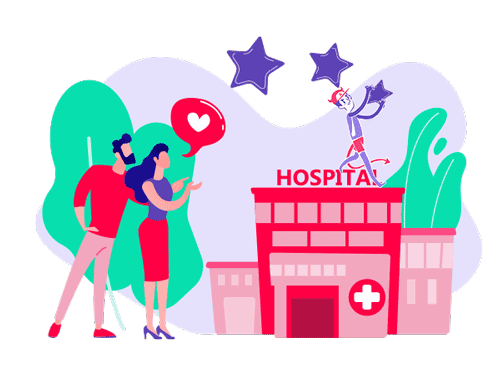3D mapping and indoor geolocation offer a solution by making it easier and faster to find a destination. This technology provides precise step-by-step directions and navigation, improving the overall experience of patients and visitors in hospitals. It can be implemented on a mobile app or using QR Codes. Patients can find and locate a department or office on the hospital website prior to their visit. With a navigation app, they can get real-time directions directly on their mobile device.
Why set up a geolocation system ?
Getting to the hospital can be stressful and daunting, whether it’s for an emergency, an appointment or to visit someone. Healthcare spaces are often large, complex and ever-changing, making navigation difficult. That’s why hospitals should consider using 3D mapping and indoor geolocation to help patients and visitors navigate the hospital and provide quality care.
Navigating in a hospital can be challenging due to its complex layouts. Patients arriving at the hospital are often stressed and need help finding their destination quickly. Unfortunately, there are often few distinguishing features to guide them and many current navigation tools are not satisfactory.
What benefits?
Location-based services, such as security alerts and push notifications, can inform people of nearby sanitation stations or temporarily closed areas, such as hallways, restrooms or elevators.
With the flexibility of a geolocation and 3D mapping platform, managers can easily temporarily close off certain areas of the hospital. This ensures that geolocation is suppressed across these closed sites. For example, if a hallway or stairwell is too narrow to allow for social distance, navigation can be suppressed so that guests are not led to these areas. In addition to improving social distance, this technology can be used to control traffic flow in a hospital.
Another important feature of indoor geolocation technology is that the accessibility mode is automatically activated. This provides patients with accessible routes that use elevators and ramps rather than stairs. This is crucial in the healthcare sector, as it ensures a safe route from point A to point B.
Hospitals can also use indoor positioning to gain insight into their patients and visitors, and how they interact with the space. In turn, they can use this data to provide an improved and safer space. For example, if a large number of patients and staff members are looking for an elevator in a specific area, hospitals may consider installing one. All things considered, there are countless ways this technology can be used to keep everyone in the hospital safe.
Prospects for the future
We can see that 3D mapping and geolocation technology is improving the patient experience in healthcare. By implementing this technology, hospitals can reduce the frustration and stress that patients face when trying to navigate the maze of buildings, floors and departments. Being able to get people safely to where they need to go will not only save time and resources, but also improve patient and visitor satisfaction. This technology can also be leveraged to improve safety measures throughout the hospital and provide a consistent 3D mapping experience across multiple platforms.
Indoor mapping is already the future with intelligent indoor travel! Discover our 3D digital mapping solution and all our indoor geolocation services on Sweepin.en.


